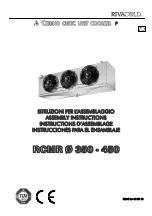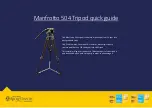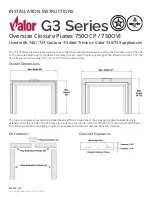
RCMR Pag. 30 Rev. 02 02 13
UK
3.3.1.3 Cautions to be followed during Lifting and Transport
During the lifting and transport phases, the cautions described in this paragraph must be followed.
For these operations, only designate specialized personnel trained concerning the procedures to handle machineries and
capable of choosing and safely using the lifting and transport devices most suitable to the given circumstance (e.g. hoist, lifts).
Check and, if need be, make sure that all the parts that can move are properly fastened (or, if required, removed and
reassembled when the operation is completed).
Do not for any reason whatsoever lift the various parts of the
PARTLY COMPLETED MACHINERY
by grabbing it by its non-structural
elements (e.g. wires or sheaths).
Make sure there are no persons near the area where the lifting, handling, and unloading operations are taking place, and
always keep at a safety distance.
Always pre-alert that maneuvers are about to commence.
Do not transit beneath hanging loads.
Do not let yourself be transported together with the loads.
3.3.2 Installation and Hook-up
3.3.2.1 Residual risks present during Installation and Hook-up
There are risks during the installation and hook-up phases tied to:
operations on the
PARTLY COMPLETED MACHINERY
by unqualified, untrained, uninformed, or improperly equipped personnel.
contact with elements under voltage;
collision or crushing by components of the
PARTLY COMPLETED MACHINERY
being handled;
tripping or falling near electrical power connections;
damage of the
PARTLY COMPLETED MACHINERY
during the installation and hook-up phases.
3.3.2.2 Necessary Individual Protection Devices
3.3.2.3 Included warning signs
The
PARTLY COMPLETED MACHINERY
is equipped with specific danger and prohibition signs; in this respect, see
Paragraph 3.4 - Signs
concerning Safety
.
3.3.2.4 Cautions to be followed during Installation and Hook-up
During the installation and hook-up phases, the cautions described in this paragraph must be followed.
Follow the indications relative to safety reported in
Paragraph 3.3.1 - Lifting and Transport
during the necessary handling
operations on the
PARTLY COMPLETED MACHINERY
.
Use the auxiliary equipment and, at any rate, any other machinery or tool (electrical or pneumatic) only after having understood
the indications reported in the relative Use and Maintenance Manuals, or after having undergone specific and formal training.
Protect the piping of the connections to the energy sources with rigid sheaths or adequate wire feed-thru conduits.
Perform the required interventions using work tools up to norm (ladders, various tools) and paying utmost attention to elements
that could lead to tripping or cause cuts and contusions.
3.3.3 Maintenance and Demolition
3.3.3.1 Residual risks present during Maintenance and Demolition
There are risks during the maintenance and demolition phases tied to:
operations on the
PARTLY COMPLETED MACHINERY
by unqualified, untrained, uninformed, or improperly equipped personnel.
collision and crushing by components of the
PARTLY COMPLETED MACHINERY
being handled;
contact with hot elements of the
PARTLY COMPLETED MACHINERY
or of the relative equipment;
contact with refrigerant fluid.
3.3.3.2 Necessary Individual Protection Devices
3.3.3.3 Included warning signs
The
PARTLY COMPLETED MACHINERY
is equipped with specific danger and prohibition signs; in this respect, see
Paragraph 3.4 - Signs
concerning Safety
.
3.3.3.4 Cautions to be followed during Maintenance and Demolition
During the maintenance and demolition phases, the cautions described in this paragraph must be followed.
Perform the required interventions using work instruments up to norm (ladders, various tools) and always wearing the necessary
IPD.
The maintenance and demolition interventions must be performed by qualified and specifically trained personnel.
Check that the power supplies have been duly disconnected and that no one can reactivate them before the required
interventions are concluded (need to act on the main on/off switch, supplied as a separate optional feature, of each fan motor;








































